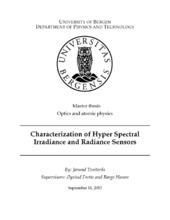Characterization of Hyper Spectral Irradiance and Radiance Sensors
Master thesis
Permanent lenke
https://hdl.handle.net/1956/7681Utgivelsesdato
2013-09-11Metadata
Vis full innførselSamlinger
Sammendrag
It is surprisingly problematic to to accurately measure light in the laboratory. Even more so when measuring in the field. There are lots of areas where measuring light spectrum and irradiance outside a laboratory is of great interest. For instance spectra which vary with algae concentrations in the sea, concentration of different gases in the atmosphere and UV radiation to name a few. Trios has made a versatile set of irradiance and radiance sensors for different types of wavelength ranges, that could potentially be very well suited for these types of tasks. However there have been observed some inaccurate data when using them in the field. In this thesis we will take a closer look at the different Trios Ramses sensors and their characteristics to see if there are any errors in the sensors. If any errors are present look for corrections or improvements to these errors. There are certain areas that are known to be problematic when measuring light irradiance, like the cosine response. This and other aspects have been carefully tested in a laboratory environment. We have used these results to make corrections to the field measurements. Finally compared the corrected measurements to the results calculated from a radiative transfer model.
